National Standardised Assessments for Scotland: national report - academic year 2023-2024
Summary of outcomes at a national level on the 'Scottish National Standardised Assessments' (SNSA) and ‘Measaidhean Coitcheann Nàiseanta airson Foghlam tron Ghàidhlig’ (MCNG) (collectively known as NSA) in the 2023 to 2024 academic year.
2 Numeracy
2.1 The scope of the numeracy assessment
2.1.1 Numeracy for P1, P4, P7 and S3
For both SNSA and MCNG, there were separate assessments of numeracy for P1, P4, P7 and S3 (though assessment data shows that Gaelic Medium learners tend to take the SNSA Numeracy assessment at S3). The same set of organisers was used for each of the assessments, with the proportion of items in each organiser varying by stage to reflect the change in emphasis on each area within Curriculum for Excellence (CfE).
2.1.2 A note on contexts used in the numeracy NSA
For numeracy assessments within NSA, a wide variety of simple contexts was used. Typically, items were short and discrete, so contexts were relatively straightforward in nature, covering a mix of everyday life and the school environment.
All items were reviewed by Education Scotland for their appropriateness to the Scottish context, prior to inclusion in the assessments.
MCNG items are written by Gaelic Medium Education practitioners and quality assured by a panel, chaired by Education Scotland. MCNG items also follow the same trialling process as SNSA items.
2.2 Coverage of Curriculum for Excellence
NSA is just one part of the range of assessments that teachers use in making their evaluations of children's and young people's learning. It has been possible to assess most areas of the numeracy Experiences and Outcomes within this standardised assessment, using closed response items that can be automatically marked. The assessments comprise between 27 and 30 items per learner, according to stage. Due to the adaptive nature of the assessments, there will be variation in specific areas assessed in different assessments, according to the learner’s individual pathway. The assessment items for the NSA reflect the knowledge, skills understanding, and standards embedded within the Curriculum for Excellence Experiences and Outcomes for reading, writing and numeracy across the CfE Levels, in accordance with the most up to date Education Scotland advice and curricular guidance on experiences and outcomes and Benchmarks. To note: although mathematics Experiences and Outcomes are included within the Curriculum for Excellence document Benchmarks: Numeracy and Mathematics, these are not assessed within NSA, since the numeracy assessment only assesses the numeracy Experiences and Outcomes.
All four organisers were represented in the P1, P4, P7 and S3 numeracy assessments, with different proportions across the stages. In the reports provided to schools, teachers received information about the outcomes of the learner at the organiser level, if the learner was presented with at least five items from that organiser. Similarly, in this report, outcomes for organisers that were addressed by at least five items in each learner's assessment are analysed.
The information in sections 2.2.1 - 2.2.4 apply to SNSA. MCNG examples and descriptions can be found in sections 2.2.5 - 2.2.8 of this report.
2.2.1 SNSA Number
The main focus of this organiser is understanding the properties of numbers and the ability to use the four basic number operations. It included items that asked about estimating and rounding; number and number processes; addition, subtraction, multiplication and division; and place value. In P7 and S3, negative numbers were also assessed. This organiser could be regarded as containing some of the basic building blocks of numeracy: the ability to engage with content in the other organisers is dependent to some extent upon the ability to understand place value and properties of number, as well as being able to understand and use the four basic operations of addition, subtraction, multiplication and division.
Please note that the item included in Figure 3 and all subsequent figures throughout this report have not been included in any of the assessments since the 2022 to 2023 academic year, and they will not be included in any future SNSA.
Figure 3 shows a Number item from the S3 numeracy assessment.
Figure 3. Example of an S3 Number item: assessing addition of decimal fractions

In this item, learners solve an addition problem working with decimal fractions to two and three decimal places, without the use of context. It builds on young people's existing knowledge of place value in whole numbers to assess their understanding of place value in decimal numbers. This item comes from the middle of the item difficulty range for the S3 numeracy assessment.
2.2.2 SNSA Fractions, decimal fractions and percentages
The main focus of this organiser is on the ability to recognise and work with fractions, decimal fractions and percentages. At P1, this involves sharing objects into equal sets and recognising representations of halves. By P4, children were asked to recognise standard fraction notation for common fractions, order fractions by size, and recognise pictorial representations of fractions. In the P7 assessment, children were also assessed on their current capacity to work with decimal fractions and percentages, recognise equivalent values in the different forms, and find fractions and percentages of a quantity. At S3, young people were also assessed on their current capacity to work with ratios.
In the assessments for the later stages, there was an increase in the number of items assessing this organiser. This shift in the assessments' weightings reflects learners' increasing familiarity with whole numbers, and the transition to applying their understanding of how to calculate with whole numbers to their growing understanding of Fractions, decimal fractions and percentages.
Figure 4 shows a difficult Fractions, decimal fractions and percentages item focusing on percentages from the P7 numeracy assessment.
Figure 4. Example of a P7 Fractions, decimal fractions and percentages item: assessing ability to find a percentage of a quantity

This item asks children to calculate a given percentage of an amount. The use of 5% as the percentage in the question prompt enables children to use a variety of approaches to solving the problem. The most likely strategy would be the standard approach of dividing by 100 and then multiplying by five; alternatively, children may make use of known facts to divide by 10 and then halve. The use of vinegar as a context enables children to demonstrate that they are able to apply their knowledge to situations where they may not have previously worked with percentages.
Figure 5 shows a Fractions, decimal fractions and percentages item from the S3 numeracy assessment.
Figure 5. Example of a potential S3 Fractions, decimal fractions and percentages item: calculating a new total after a given percentage increase
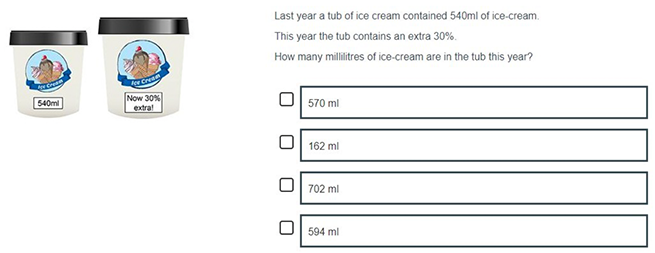
This item asks young people to calculate a new total after a given percentage increase, in the context of capacity. The wrong answers represent the ways in which the learners could miscalculate the change in total. This item would be above average difficulty for the S3 numeracy assessment.
2.2.3 SNSA Measurement, time and money
This organiser draws together the numeracy Benchmarks that cover measurement, time and money. The measurement strand of SNSA progresses from comparing and ordering, and the use of non-standard units of measure at P1, to the use of standard units, reading scales and estimation, and calculating areas by counting squares or other methods at P4. At P7, children are expected to be estimating using standard units of measures and calculate areas of squares, rectangles and right-angled triangles. By S3, young people were asked to demonstrate that they could calculate other areas and volumes and convert between standard units of measure. Money at P1 and P4 focused on the recognition of coin values and calculating change, with P4 additionally covering accurate use of pounds and pence notation. At P7 and S3, budgeting, calculating profit and loss, and currency conversion also featured. Time covered areas such as reading clock times, interpreting timetables, calculating time durations and speed/distance/time calculations, as appropriate for each stage.
Figure 6 shows an item from the middle of the difficulty range for the P4 numeracy assessment, reflecting the measurement aspect of the organiser.
Figure 6. Example of a potential P4 Measurement, time and money item: convert hour and minutes to minutes only

The focus of this item is on converting hour and minutes to minutes only. This looks to identify if learners are able to identify the number of minutes in an hour and use this to complete a calculation. This is from the upper end of the difficulty scale for P4.
Figure 7 shows a typical P1 numeracy item, reflecting the time aspect of the organiser.
Figure 7. Example of a potential P1 Measurement, time and money item: choose the clock that shows the stated time
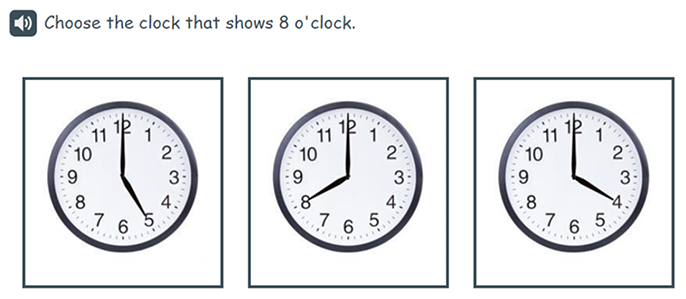
This item is designed to assess children's ability to read o'clock times on analogue clocks. In this instance, children were asked to select the analogue clock from a given time. Typically, in SNSA and other assessments for this age group, learners’ understanding of analogue clocks correlates less well with overall capacity in numeracy than is the case for many other aspects of numeracy. As such, typically, there is less of a difference in outcomes for learners working across the capacity range than for other areas of numeracy. This may be due to experiences outside of school that affect children's understanding of this aspect more than in other areas of numeracy.
Figure 8 shows an item reflecting the money aspect of the organiser.
Figure 8. Example of a P1 Measurement, time and money item: assessing understanding of coin values
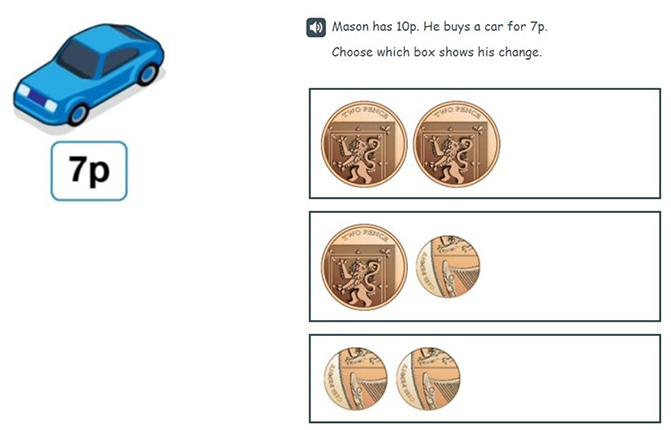
This item is designed to assess recognition of coin values with the context of a calculation. Retaining and processing both pieces of information in a two-step problem adds an additional level of challenge. Coin recognition is a skill which P1 learners seem to find more challenging, especially below £1.
2.2.4 SNSA Information handling
The main focus of this organiser is on data and analysis. It involves the use and interpretation of a wide range of increasingly complex tables, charts and graphs. At P1, this begins with sorting and categorising objects according to specified criteria. Forms of data presentation that are assessed include Venn and Carroll diagrams, tally charts, tables, block graphs, bar graphs, line graphs and pie charts; types of charts that are covered vary according to stage. Scales on the charts progress in complexity from those numbered in ones to having scales where not all values are marked. From P4 onwards, elements of probability, as detailed in the 'chance and uncertainty' Benchmarks, are also assessed. This includes the language of chance and also the use of the 0 to 1 probability scale.
Figure 9 shows an item from the lower end of the difficulty range for the P7 numeracy assessment, reflecting the data and analysis aspect of the organiser.
Figure 9. Example of a P7 Information handling item: identifying the tally chart that matches a given bar graph
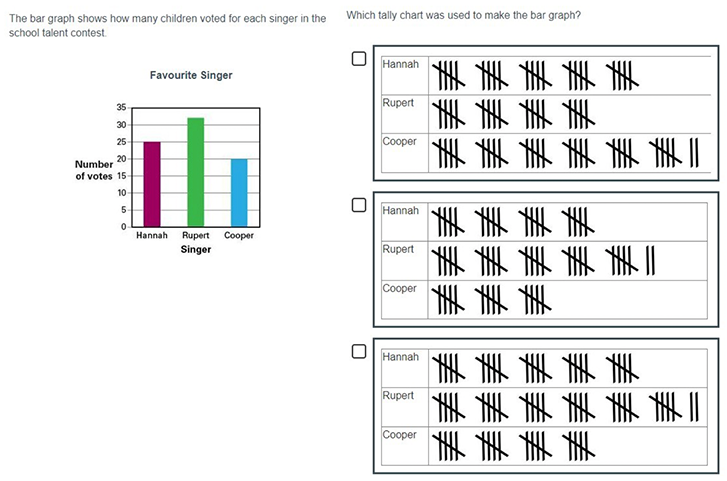
This item shows a simple column graph where the scale is numbered in fives and three tally charts of data. From these, the learner must select the correct tally chart which was used to create the graph.
2.2.5 – MCNG Number
The main focus of this organiser is understanding the properties of numbers and the ability to use the four basic number operations. It included items that asked about estimating and rounding; number and number processes; addition, subtraction, multiplication and division; and place value. In P7 and S3, negative numbers were also assessed. This organiser could be regarded as containing some of the basic building blocks of numeracy: the ability to engage with content in the other organisers is dependent to some extent upon the ability to understand place value and properties of number, as well as being able to understand and use the four basic operations of addition, subtraction, multiplication and division.
Figure 10 shows an example item from P1 Number.
Figure 10. Example of a P1 Number item: subtraction
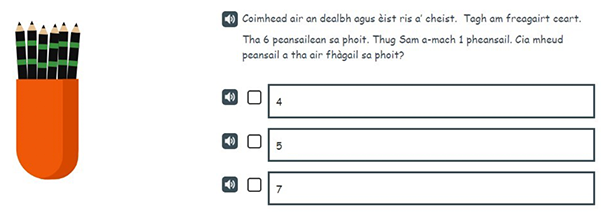
This item is designed to assess a learner’s ability to subtract one number from another and identify the correct answer. This item has audio support for the learners, as well as visual support.
Figure 11 is another example of a P1 Number item which assesses basic counting skills.
Figure 11. Example of a P1 Number item: counting

This item asks learners to count the number of apples and oranges on the plate.
2.2.6 – MCNG Fractions, decimal fractions and percentages
The main focus of this organiser is on the ability to recognise and work with fractions, decimal fractions and percentages. At P1, this involves sharing objects into equal sets and recognising representations of halves. By P4, children were asked to recognise standard fraction notation for common fractions, order fractions by size, and recognise pictorial representations of fractions. In the P7 assessment, children were also assessed on their current capacity to work with decimal fractions and percentages, recognise equivalent values in the different forms, and find fractions and percentages of a quantity. At S3, young people were also assessed on their current capacity to work with ratios.
In the assessments for the higher stages, there was an increase in the number of items assessing this organiser. This shift in the assessments' weightings reflects learners' increasing familiarity with whole numbers, and the transition to applying their understanding of how to calculate with whole numbers to their growing understanding of Fractions, decimal fractions and percentages.
Figure 12 asks learners to work with fractions to calculate how many of an item are left after 35% of them have been sold.
Figure 12. Example of a P7 Fractions, decimal fractions and percentages item: calculating the remaining number after subtracting a fraction
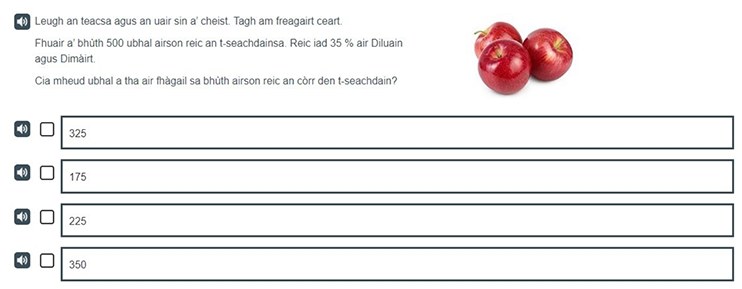
This item asks learners to calculate how many apples are left after a percentage of the original have been sold.
Figure 13 shows an example item from an S3 Fractions, decimal fractions and percentages assessment.
Figure 13. Example of an S3 Fractions, decimal fractions and percentages item: calculating a number based on a fraction.
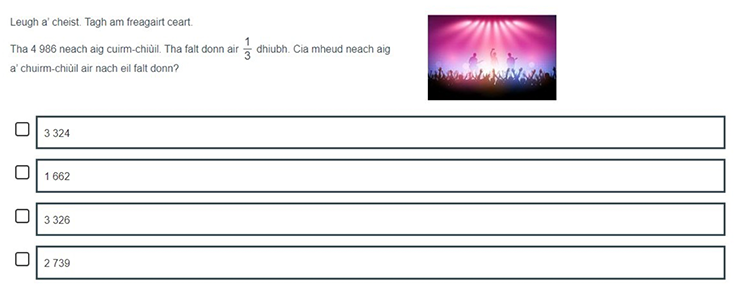
This multi-step item assesses learners’ ability to calculate a number based on a fraction and then subtract that number from a total. Although this is a multi-step item, it is an easier item for S3 Fractions, decimal fractions and percentages.
2.2.7 – MCNG Measurement, time and money
This organiser draws together the numeracy Benchmarks that cover measurement, time and money. The measurement strand of MCNG progresses from comparing and ordering, and the use of non-standard units of measure at P1, to the use of standard units, reading scales and estimation, and calculating areas by counting squares or other methods at P4. At P7, children are expected to be estimating using standard units of measures and calculate areas of squares, rectangles and right-angled triangles. By S3, young people were asked to demonstrate that they could calculate other areas and volumes and convert between standard units of measure. Money at P1 and P4 focused on the recognition of coin values and calculating change, with P4 additionally covering accurate use of pounds and pence notation. At P7 and S3, budgeting, calculating profit and loss, and currency conversion also featured. Time covered areas such as reading clock times, interpreting timetables, calculating time durations and speed/distance/time calculations, as appropriate for each stage.
Figure 14 shows an example item from a P4 assessment which assesses the learners’ ability to add time intervals.
Figure 14. Example of a P4 Measurement, time and money item: adding time intervals
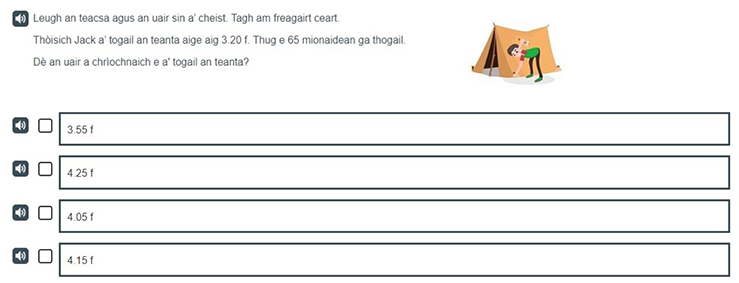
This item asks learners to add 65 minutes to a starting time, assessing their ability to add time in increments of more than one hour. This type of item would be towards the harder end of difficulty for P4.
2.2.8 – MCNG Information handling
The main focus of this organiser is on data and analysis. It involves the use and interpretation of a wide range of increasingly complex tables, charts and graphs. At P1, this begins with sorting and categorising objects according to specified criteria. Forms of data presentation that are assessed include Venn and Carroll diagrams, tally charts, tables, block graphs, bar graphs, line graphs and pie charts; types of charts that are covered vary according to stage. Scales on the charts progress in complexity from those numbered in ones to having scales where not all values are marked. From P4 onwards, elements of probability, as detailed in the 'chance and uncertainty' Benchmarks, are also assessed. This includes the language of chance and also the use of the 0 to 1 probability scale.
Figure 15 shows an example probability item from a P4 assessment.
Figure 15. Example of a P4 Information handling: probability
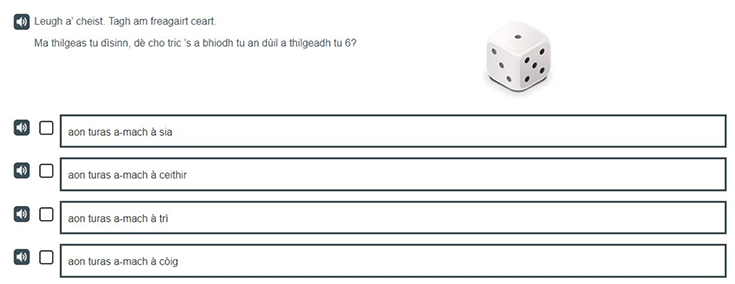
This item asks learners what the probability of throwing a six with a six-sided dice is. This item would be a difficult item for P4 learners.
2.3 SNSA National outcomes for numeracy[7]
2.3.1 Overall outcomes
Charts 1a to 1d show, for each stage (P1, P4, P7 and S3), the overall outcomes of learners for numeracy. Where learners are presented with more than 5 items per organiser, they additionally show the outcomes of learners according to the knowledge organisers: Number (NUM), Fractions, Decimal fractions and Percentages (FDP), Measurement, Time and Money (MTM) and Information Handling (IH). The bars show outcomes across the six capacity bands that are specific to each stage, in line with SNSA reports for the academic year 2023 to 2024.
For P1 and S3, the majority of learners achieved outcomes in the mid to upper bands, and for P4 and P7 learners, the middle bands were the most frequently achieved by learners.
Please note that for all charts, a notable difference refers to a difference of 10 percent or more, a small difference refers to any difference between 5 percent and 10 percent.
Chart 1a. SNSA Numeracy outcomes for P1
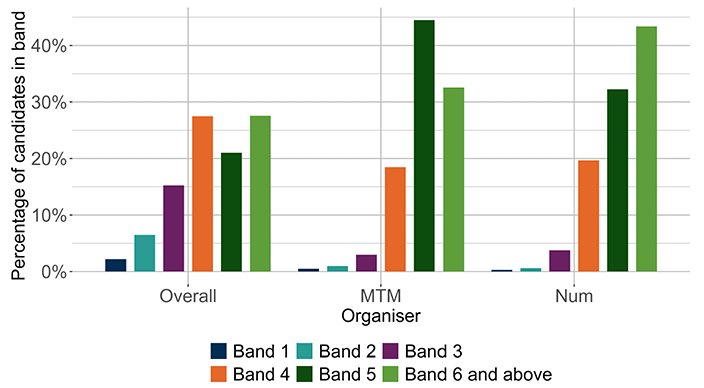
Overall for P1, the band achieved by the largest proportion of learners was band 6, with over a quarter of learners (27.6 percent) achieving this band. The second most common band achieved by learners was band 4. The band achieved by the smallest proportion of participants was band 1 with only 2.21 percent of learners scoring in this band. Approximately 76.1 percent of learners achieved bands 4 to 6.
For the 'Money, time and measurement' organiser, 77.1 percent of learners achieved the upper bands (5 and 6). The modal band for this organiser differed from the overall summary, with band 5 achieved by the largest proportion of learners instead.
For the 'Number' organiser, 75.7 percent of learners achieved bands the upper bands (5 and 6). As for the overall summary, the 'Number' organiser had the largest proportion of learners achieving outcomes in band 6.
Chart 1b. SNSA Numeracy outcomes for P4
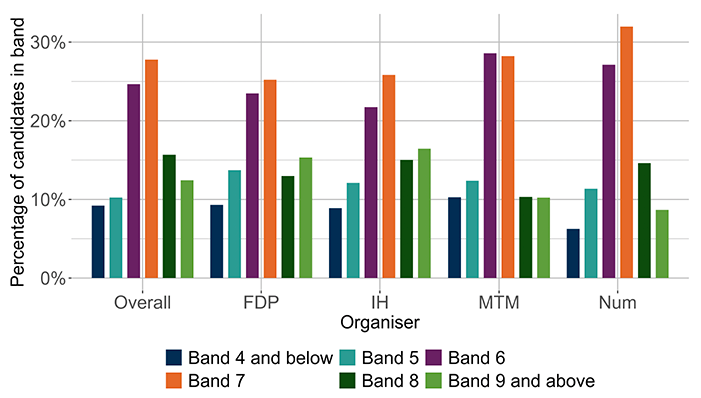
Overall for P4, band 7 was achieved by the largest proportion of learners with 27.8 percent of learners achieving this band, the second most common band was band 6. The least frequently achieved band for P4 learners was band 4, with only 9.2 percent of learners scoring in this band. Approximately 68.1 percent of learners achieved bands 6 to 8 and 90.8 percent of learners achieved bands 5 to 9.
As in the overall summaries, band 7 was achieved by the largest proportion of learners for each of the organisers, with the exception of the ‘Money, time and measurement’ organiser, for which band 6 was the most common outcome.
For the 'Fractions, decimal fractions and percentages' organiser, 61.7 percent of learners achieved bands 6 to 8 and 90.7 percent of learners achieved bands 5 to 9. Similarly, for the 'Information handling' organiser, 62.6 percent of learners achieved bands 6 to 8 and 91.1 percent of learners achieved bands 5 to 9. Likewise, for the 'Money, time and measurement' organiser, 67.1 percent of learners achieved bands 6 to 8 and 89.7 percent of learners achieved bands 5 to 9. Finally, for the 'Number' organiser, 73.7 percent of learners achieved bands 6 to 8 and 93.7 percent of learners achieved bands 5 to 9.
Chart 1c. SNSA Numeracy outcomes for P7
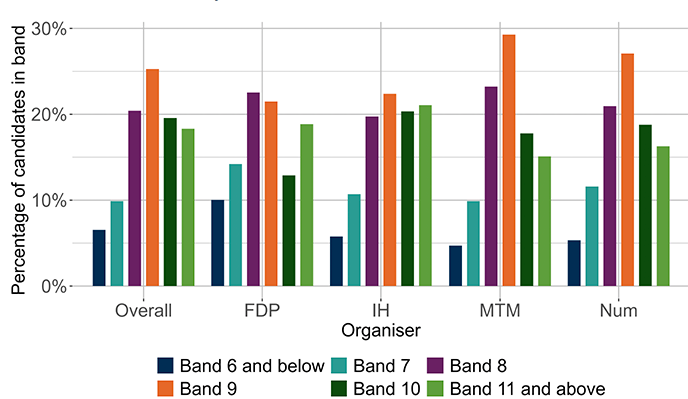
Overall for P7, the band achieved by the largest proportion of learners was band 9, with 25.3 percent of learners scoring in this band, and the second most common band achieved was band 8. The band achieved by the smallest proportion of learners was band 6 with only 6.6 percent of learners scoring in this band. Approximately 65.2 percent of learners achieved bands 8 to 10 and 93.5 percent of learners achieved bands 7 to 11.
As in the overall summaries, band 9 was the modal band achieved by learners for each of the organisers, with the exception of the ‘Fraction, decimal fractions and percentages’ organiser, for which band 8 was the most common outcome.
For the 'Fractions, decimal fractions and percentages' organiser, 56.9 percent of learners achieved bands 8 to 10 and 90.0 percent of learners achieved bands 7 to 11. Similarly, for the 'Information handling' organiser, 62.5 percent of learners achieved bands 8 to 10 and 94.2 percent of learners achieved bands 7 to 11. Additionally, for the 'Money, time and measurement' organiser, 70.3 percent of learners achieved bands 8 to 10 and 95.3 percent of learners achieved bands 7 to 11. Likewise, for the 'Number' organiser, 66.8 percent of learners achieved bands 8 to 10 and 94.7 percent of learners achieved bands 7 to 11.
Chart 1d. SNSA Numeracy outcomes for S3
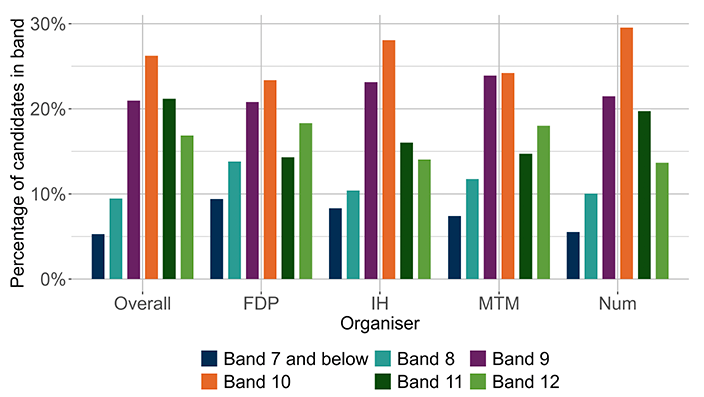
Overall for S3, band 10 was achieved by the largest proportion of learners (26.2 percent of learners) and the second most frequently achieved band was band 11. The band achieved by the smallest proportion of participants was the lowest band, band 7, with only 5.3 percent of learners scoring in this band. Approximately 68.4 percent of learners achieved bands 9 to 11 and 94.7 percent of learners achieved bands 8 to 12.
For the 'Fractions, decimal fractions and percentages' organiser, 58.5 percent of learners achieved bands 9 to 11 and 90.6 percent of learners achieved bands 8 to 12. For the 'Information handling' organiser, 67.2 percent of learners achieved bands 9 to 11 and 91.7 percent of learners achieved bands 8 to 12. For the 'Money, time and measurement' organiser, 62.8 percent of learners achieved bands 9 to 11 and 92.6 percent of learners achieved bands 8 to 12. For the 'Number' organiser, 70.8 percent of learners achieved bands 9 to 11 and 94.5 percent of learners achieved bands 8 to 12.
As with the overall summary, for each of the organisers, the largest proportion of learners achieved outcomes in band 10.
2.3.2 Sex
Charts 2a to 2d show outcomes for male and female learners for each stage (P1, P4, P7 and S3). Outcomes are given for the overall outcomes and by organiser.
For P1, P4, P7 and S3 there were no notable differences between the outcomes of male and female learners in both the overall and organiser summaries. There were small differences at all stages other than P1 at either an overall or organiser level.
Chart 2a. SNSA Numeracy outcomes distributed by sex for P1

Overall and for the ‘Number’ and ‘Money, time and measurement’ organisers, there were no differences, notable or small, between the proportion of females and males achieving outcomes in each band.
Chart 2b. SNSA Numeracy outcomes distributed by sex for P4
Overall and for each of the organisers, there were no notable differences between the proportion of females and males achieving outcomes in each band.
For the overall summary, there were small differences between the proportion of female and male learners achieving outcomes in band 9 with a greater proportion of male learners achieving a band 9 than female learners, but no differences for all other bands. There were no small differences between the proportion of male and female learners achieving outcomes in each band for the organisers.
Chart 2c. Numeracy outcomes distributed by sex for P7
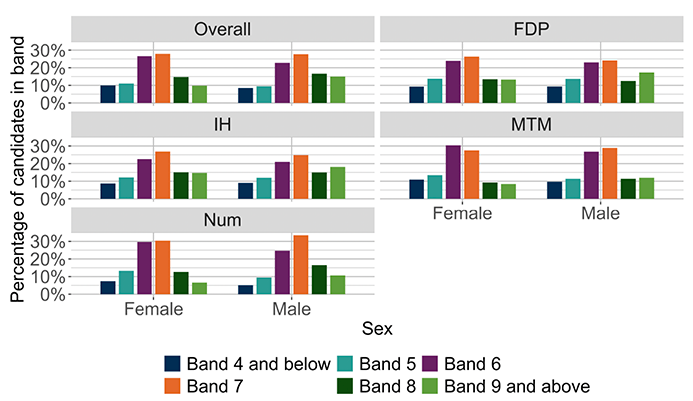
There were no notable differences between the proportion of females and males achieving outcomes in each band overall and for each organiser.
Overall, there were small differences between the proportion of females and males achieving outcomes in bands 8 and 11 with a greater proportion of females achieving outcomes in band 8 than male learners and a greater proportion of male learners achieving outcomes in band 11.
For the organisers, with the exception of the ‘Information handling’ organiser which had no small differences in any band, there were small differences in the proportion of male and female learners achieving band 11. The 'Fractions, decimal fractions and percentages' organiser also showed small differences in band 7 and there were small differences in band 8 for the 'Money, time and measurement' organiser. There was no difference for all other bands.
Chart 2d. SNSA Numeracy outcomes distributed by sex for S3
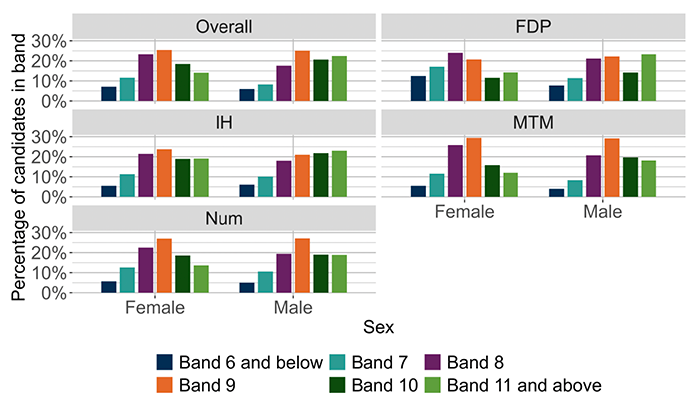
There were no notable differences between the proportion of females and males achieving outcomes in each band overall and for each organiser.
Overall, there were small differences between the proportion of females and males achieving outcomes in band 12 with a greater proportion of male learners achieving an outcome in this band. The 'Fractions, decimal fractions and percentages', 'Information handling' and 'Money, time and measurement' organisers also had small differences between the proportion of females and males achieving outcomes in band 12. For these organisers there was no difference for all other bands, and there were no small differences in any band for the 'Number' organiser.
2.3.3 Scottish Index of Multiple Deprivation
This section reviews the distribution of learners for all stages across categories that reflect the Scottish Index of Multiple Deprivation (SIMD). To simplify the display of outcomes and aid their interpretation, we have divided the original 20 categories (vigintiles) into three combined categories of socio-economic background. These combined categories are: SIMD 1–4, indicating the lowest socio-economic quintile (that is, the most deprived children and young people, those in vigintiles 1 to 4); SIMD 5–16, indicating the three middle quintiles (vigintiles 5 to 16); and SIMD 17–20, indicating the highest socio-economic quintile (that is the least deprived children and young people, those in vigintiles 17 to 20).
Charts 3a to 3d show for each stage (P1, P4, P7 and S3), the proportions of learners achieving each capacity band for learners within these SIMD categories, for both overall outcomes and outcomes in each organiser.
At each stage, the proportion of learners with outcomes in the upper capacity band was largest among learners in the least deprived group (SIMD 17–20) and lowest in the most deprived group (SIMD 1-4). The reverse is true for the lowest capacity bands, where there was a higher proportion of learners from the most deprived group (SIMD 1-4) with these outcomes. These trends hold for numeracy overall and for outcomes by organiser.
The charts show that the differences in the numeracy outcomes for the most deprived and least deprived quintiles are more pronounced in later stages than at P1, where differences are comparatively small. At P1, the majority of learners across each SIMD group achieve outcomes in the mid to upper bands, whereas at later stages, most SIMD 1-4 learners achieve outcomes in the middle bands and most SIMD 17-20 learners achieve outcomes in the upper bands.
Chart 3a. SNSA Numeracy outcomes distributed by SIMD for P1
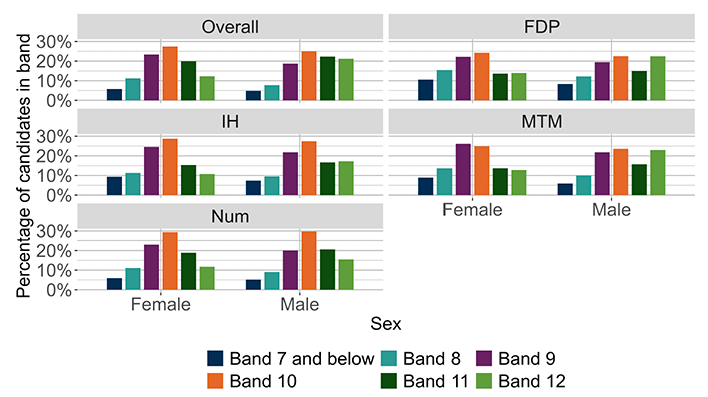
There were no notable differences for any of the SIMD groups (1-4, 5-16, 17-20) between the proportion of students achieving outcomes in each band overall and for each organiser. Overall, there was a small difference between the proportions of learners in SIMD vigintiles 1-4 and 17-20 in bands 2, 5 and 6. There was no difference between the proportions of learners with other SIMD values or in other bands.
Chart 3b. SNSA Numeracy outcomes distributed by SIMD for P4
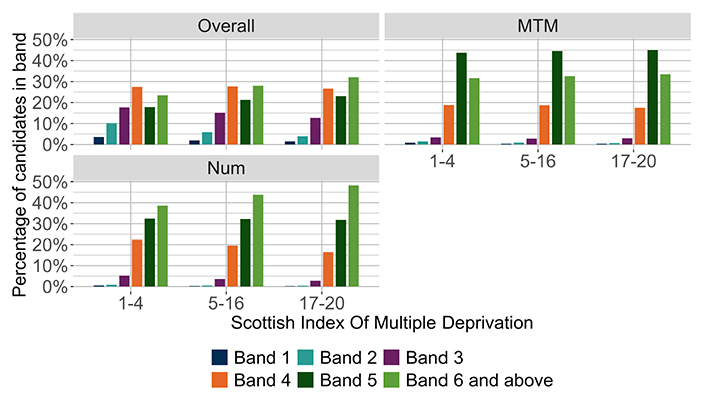
Overall, there was a notable difference between the proportions of learners in SIMD vigintiles 1-4 and 17-20 in band 9. There was no notable difference between the proportions of learners with other SIMD values or in other bands. Overall, there was a small difference between the proportions of learners in SIMD vigintiles 1-4 and 17-20 in bands 4, 5, 6 and 8, there was a small difference between the proportions of learners in SIMD vigintiles 1-4 and 5-16 in band 4, and there was a small difference between the proportions of learners in SIMD vigintiles 5-16 and 17-20 in band 6. There was no difference between the proportions of learners with other SIMD values or in other bands.
Chart 3c. SNSA Numeracy outcomes distributed by SIMD for P7
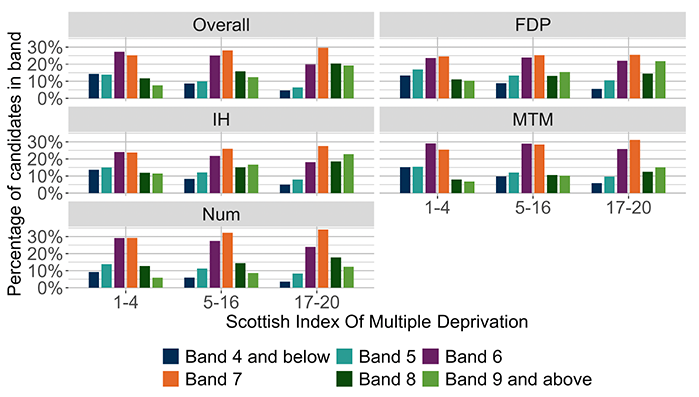
Overall, there was a notable difference between the proportions of learners in SIMD vigintiles 1-4 and 17-20 in band 11, and there was a notable difference between the proportions of learners in SIMD vigintiles 5-16 and 17-20 in band 11. There was no notable difference between the proportions of learners with other SIMD values or in other bands.
There was a small difference between the proportions of learners in SIMD vigintiles 1-4 and 17-20 in bands 6, 7, 8 and 10, there was a small difference between the proportions of learners in SIMD vigintiles 1-4 and 5-16 in band 6, and there was a small difference between the proportions of learners in SIMD vigintiles 5-16 and 17-20 in bands 7 and 8. There was no difference between the proportions of learners with other SIMD values or in other bands. There was no difference between the proportions of learners with other SIMD values or in other bands.
Chart 3d. SNSA Numeracy outcomes distributed by SIMD for S3
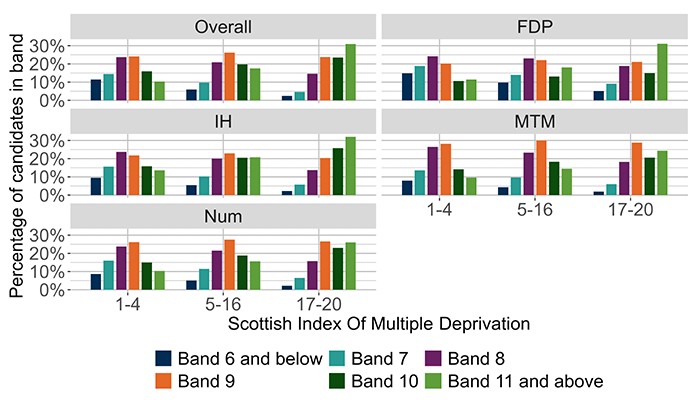
Overall, there was a notable difference between the proportions of learners in SIMD vigintiles.
1-4 and 17-20 in bands 9 and 12, and there was a notable difference between the proportions of learners in SIMD vigintiles 5-16 and 17-20 in band 12. There was no notable difference between the proportions of learners with other SIMD values or in other bands.
There was a small difference between the proportions of learners in SIMD vigintiles 1-4 and 17-20 in bands 7, 8 and 11. There was no difference between the proportions of learners with other SIMD values or in other bands.
2.3.4 Ethnic background
This section looks at differences in outcomes between learners from different ethnic backgrounds. Charts 4a to 4j show the percentages of learners in each of the major ethnic groups for P4 and P7. Outcomes for learners with missing or undisclosed ethnicity data are not included in the charts. A more granular breakdown of the number and percentages of learners in different ethnic groups who completed each assessment is available in Tables 13 to 16 in Appendix 6.
For the ethnicity outcomes, to allow for the presentation of data the MCNG ethnicity groupings differ from those used in SNSA where more granularity can be provided without identification of completers.
The outcomes show that, generally, there were only relatively small differences across the groups, both in terms of overall numeracy outcomes and when considering assessment outcomes regarding each of the organisers. For P4 and P7, generally, the middle bands were the outcome achieved by the greatest proportion of learners for each ethnic background.
At P4 and P7, among learners from Mixed and multiple ethnic groups and Asian backgrounds, there were slightly higher proportions of learners with outcomes in the upper bands than the other major ethnic backgrounds. For the lower capacity bands, there were greater proportions of learners from Caribbean or Black, African and Other backgrounds achieving these outcomes.
In line with ONS guidelines the data for P1 and S3 is not reported in order to avoid identifying individual learners.
Chart 4a. SNSA Numeracy outcomes distributed by ethnic background for P4 – overall outcomes
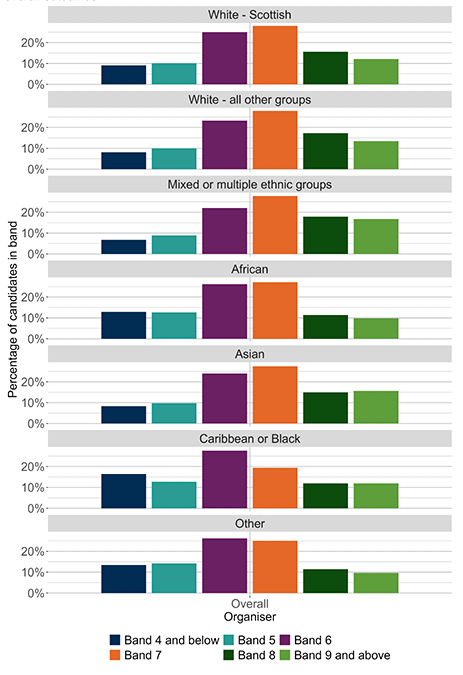
Overall, there were no notable differences between the proportions of learners from different ethnic backgrounds, but there were small differences between outcomes in all bands.
Across all ethnic background groups, the most frequently achieved bands were the middle bands (6 and 7).
There were proportionally more learners from Mixed or multiple ethnic groups and Asian backgrounds achieving outcomes in the highest capacity band and proportionally fewer learners from the African and Other groups achieving this outcome compared to the other ethnic groups presented.
There were proportionally more learners from Caribbean and Black and the Other ethnic group backgrounds achieving outcomes in the lowest capacity bands compared to the other ethnic groups presented.
Chart 4b. SNSA Numeracy outcomes distributed by ethnic background for P4 – Fractions, Decimal Fractions and Percentages

For the 'Fractions, decimal fractions and percentages' organiser, there were no notable differences between the proportions of learners from different ethnic backgrounds, but small differences in bands 4, 5, 8 and 9.
Across all ethnic background groups, the most frequently achieved bands were the middle bands (6 and 7).
There were proportionally more learners from Mixed or multiple ethnic groups and Asian backgrounds achieving outcomes in the highest capacity band and proportionally fewer learners from the African and Other group achieving this outcome compared to the other ethnic groups presented.
There were proportionally more learners from African, Caribbean and Black and the Other ethnic group backgrounds achieving outcomes in the lowest capacity bands compared to the other ethnic groups presented.
Chart 4c. SNSA Numeracy outcomes distributed by ethnic background for P4 – Information Handling
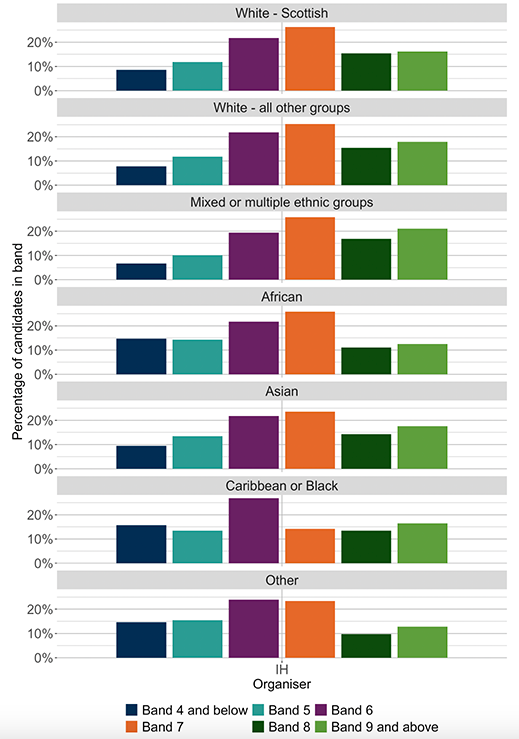
For the 'Information handling' organiser, there were notable differences between the proportions of learners from different ethnic backgrounds in band 7 and small differences in all other bands.
Across all ethnic background groups, the most frequently achieved bands were the middle bands (6 and 7).
There were proportionally more learners from Mixed or multiple ethnic groups backgrounds achieving outcomes in the highest capacity band and proportionally fewer learners from the African and Other group achieving this outcome compared to the other ethnic groups presented.
There were proportionally more learners from African, Caribbean and Black and the Other ethnic group backgrounds achieving outcomes in the lowest capacity bands compared to the other ethnic groups presented.
Chart 4d. SNSA Numeracy outcomes distributed by ethnic background for P4 – Money Time and Measurement
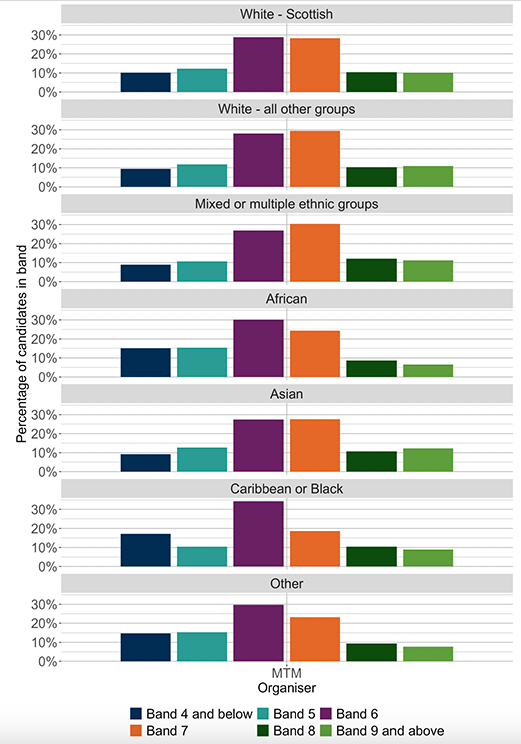
For the 'Money, time and measurement' organiser, there were notable differences between the proportions of learners from different ethnic backgrounds in band 7 and small differences in bands 4, 6 and 9.
Across all ethnic background groups, the most frequently achieved bands were the middle bands (6 and 7).
There were proportionally fewer learners in the highest capacity band from the African and Other group achieving this outcome compared to the other ethnic groups presented.
There were proportionally more learners from African, Caribbean and Black and the Other ethnic group backgrounds achieving outcomes in the lowest capacity bands compared to the other ethnic groups presented.
Chart 4e. SNSA Numeracy outcomes distributed by ethnic background for P4 – Number

For the ‘Number' organiser, there were no notable differences between the proportions of learners from different ethnic backgrounds and small differences in bands 5, 8 and 9.
Across all ethnic background groups, the most frequently achieved bands were the middle bands (6 and 7).
There were proportionally more learners from Mixed or multiple ethnic groups and Asian backgrounds achieving outcomes in the highest capacity band and proportionally fewer learners from the Other group achieving this outcome compared to the other ethnic groups presented.
There were proportionally more learners from African, Caribbean and Black and the Other ethnic group backgrounds achieving outcomes in the lowest capacity bands compared to the other ethnic groups presented.
Chart 4f. SNSA Numeracy outcomes distributed by ethnic background for P7 – overall outcomes
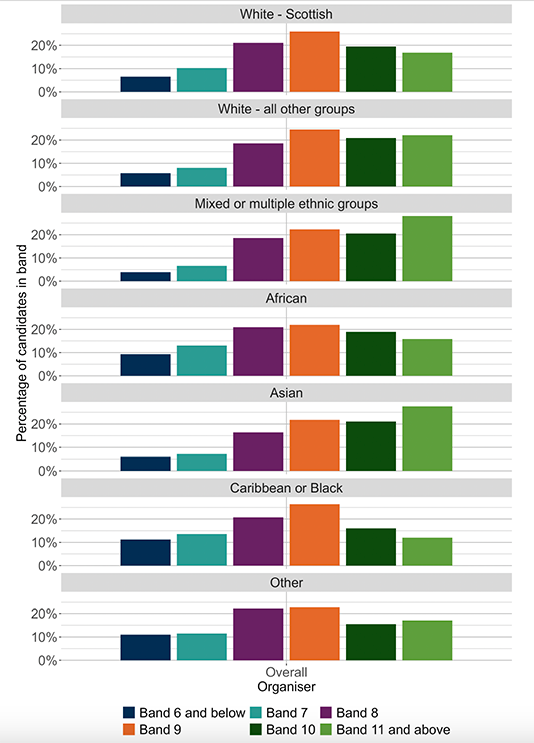
Overall, there were notable differences in band 11 between the proportions of learners from different ethnic backgrounds, but there were small differences between outcomes in bands 6, 7, 8, and 10.
Across most ethnic background groups, the most frequently achieved bands were the middle bands (8 and 9) but for learners from Mixed or multiple ethnic groups and Asian backgrounds, the highest band was most frequently achieved.
There were proportionally more learners from Mixed or multiple ethnic groups and Asian backgrounds achieving outcomes in the highest capacity band and proportionally fewer learners from the African, Caribbean or Black and Other groups achieving this outcome compared to the other ethnic groups presented.
There were proportionally more learners from Caribbean and Black and the Other ethnic group backgrounds achieving outcomes in the lowest capacity bands compared to the other ethnic groups presented.
Chart 4g. SNSA Numeracy outcomes distributed by ethnic background for P7 – Fractions, Decimal Fractions and Percentages
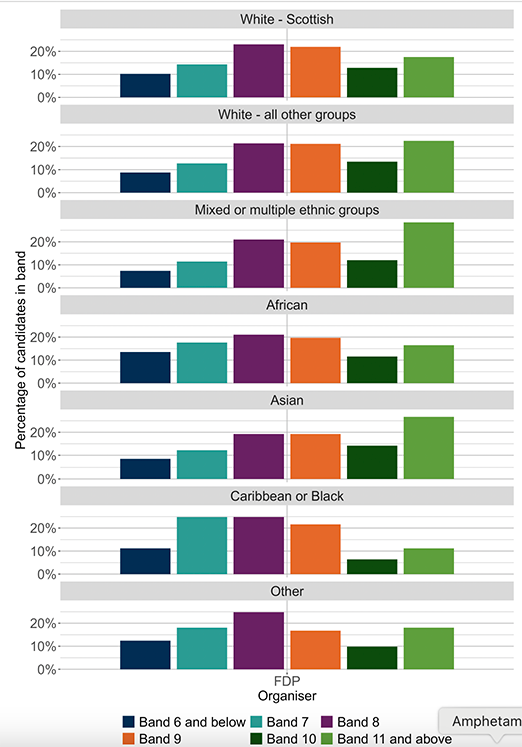
For the 'Fractions, decimal fractions and percentages' organiser, there were notable differences between the proportions of learners from different ethnic backgrounds in bands 7 and 11 and there were small differences between outcomes in all other bands.
Across most ethnic background groups, the most frequently achieved bands were the middle bands (8 and 9) and for learners from Mixed or multiple ethnic groups and Asian backgrounds, the highest band was most frequently achieved.
There were proportionally more learners from Mixed or multiple ethnic groups and Asian backgrounds achieving outcomes in the highest capacity band and proportionally fewer learners from the Caribbean or Black group achieving this outcome compared to the other ethnic groups presented.
There were proportionally more learners from African and Other ethnic group backgrounds achieving outcomes in the lowest capacity bands compared to the other ethnic groups presented.
Chart 4h. SNSA Numeracy outcomes distributed by ethnic background for P7 – Information Handling

For the 'Information handling' organiser, there were notable differences between the proportions of learners from different ethnic backgrounds in bands 11 and there were small differences between outcomes in bands 6 to 8 and 10.
Across most ethnic background groups, the most frequently achieved bands were the middle bands (8 and 9) and for learners from White – all other groups, Mixed or multiple ethnic groups and Asian backgrounds, the highest band was most frequently achieved.
There were proportionally more learners from Mixed or multiple ethnic groups background achieving outcomes in the highest capacity band and proportionally fewer learners from the African and Caribbean or Black groups achieving this outcome compared to the other ethnic groups presented.
There were proportionally more learners from African and Other ethnic group backgrounds achieving outcomes in the lowest capacity bands compared to the other ethnic groups presented.
Chart 4i. SNSA Numeracy outcomes distributed by ethnic background for P7 – Money, Time and Measurement
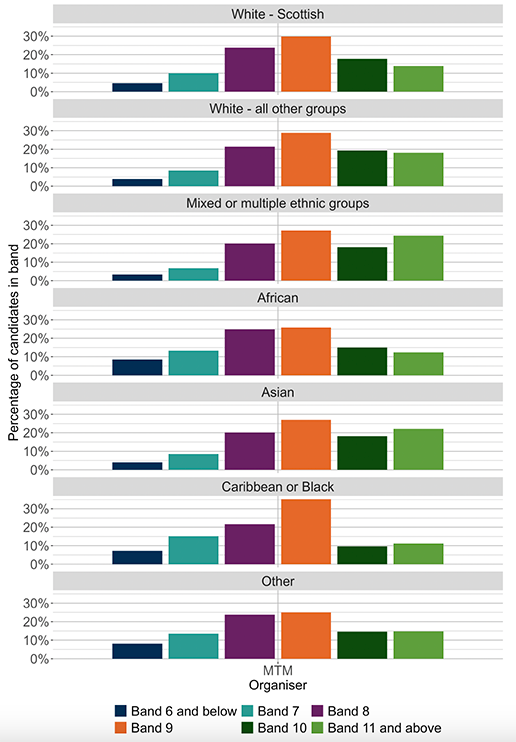
For the 'Money, time and measurement' organiser, there were notable differences between the proportions of learners from different ethnic backgrounds in bands 9 and 11 and there were small differences between outcomes in bands 6, 7 and 10.
Across all ethnic background groups, the most frequently achieved bands were the middle bands (8 and 9).
There were proportionally more learners from Mixed or multiple ethnic groups and Asian backgrounds achieving outcomes in the highest capacity band and proportionally fewer learners from the African and Caribbean or Black groups achieving this outcome compared to the other ethnic groups presented.
There were proportionally more learners from African, Caribbean or Black and Other ethnic group backgrounds achieving outcomes in the lowest capacity bands compared to the other ethnic groups presented.
Chart 4j. SNSA Numeracy outcomes distributed by ethnic background for P7 – Number
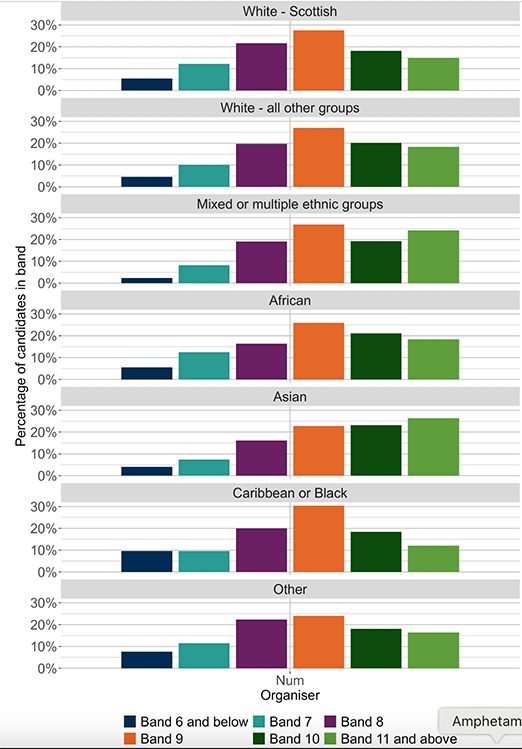
For the 'Number' organiser, there were notable differences between the proportions of learners from different ethnic backgrounds in band 11 and there were small differences between outcomes in all other bands.
Across most ethnic background groups, the most frequently achieved bands were the middle bands (8 and 9) and for learners from Asian backgrounds the most frequent outcome was the highest capacity band (band 11).
There were proportionally more learners from Mixed or multiple ethnic groups and Asian backgrounds achieving outcomes in the highest capacity band and proportionally fewer learners from the Caribbean or Black group achieving this outcome compared to the other ethnic groups presented.
There were proportionally more learners from Caribbean or Black and Other ethnic group backgrounds achieving outcomes in the lowest capacity bands compared to the other ethnic groups presented.
2.3.5 Free School Meal Entitlement
Charts 5a to 5d show numeracy outcomes of learners according to entitlement to free school meals (FME), distinguishing those with entitlement from all other learners, for each stage (P1, P4, P7 and S3). Outcomes are given for the overall outcomes and by organiser.
Across all stages, there were noticeably larger proportions with outcomes in the upper two capacity bands among learners not entitled to free school meals than among those with FME. Correspondingly, there were higher proportions of outcomes in the lower two capacity bands among learners with FME. This pattern was evident across all stages, both for numeracy overall and by organiser.
At P1, approximately 50% of learners without FME had outcomes corresponding to the two upper bands compared with less than 40% of learners with FME. While the proportion achieving outcomes in the upper bands reduced for learners without FME in later stages, generally, the majority of learners still achieved outcomes in the three highest capacity bands, whereas the majority of learners with FME achieved outcomes in the lower three capacity bands.
Chart 5a. SNSA Numeracy outcomes distributed by FME for P1
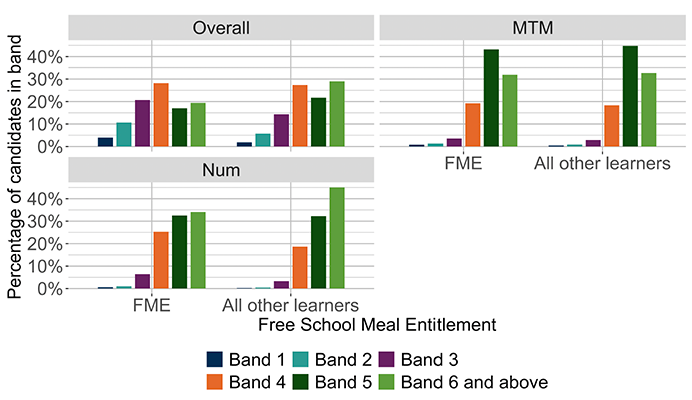
Chart 5b. SNSA Numeracy outcomes distributed by FME for P4
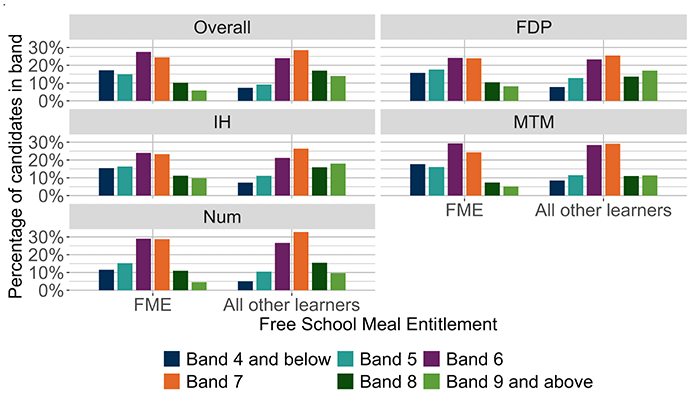
Chart 5c. SNSA Numeracy outcomes distributed by FME for P7
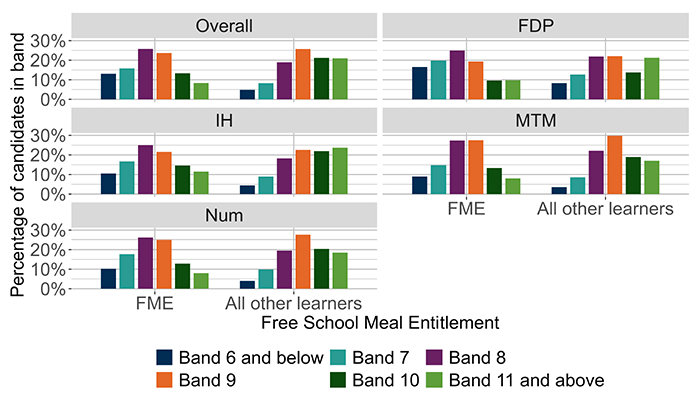
Chart 5d. SNSA Numeracy outcomes distributed by FME for S3
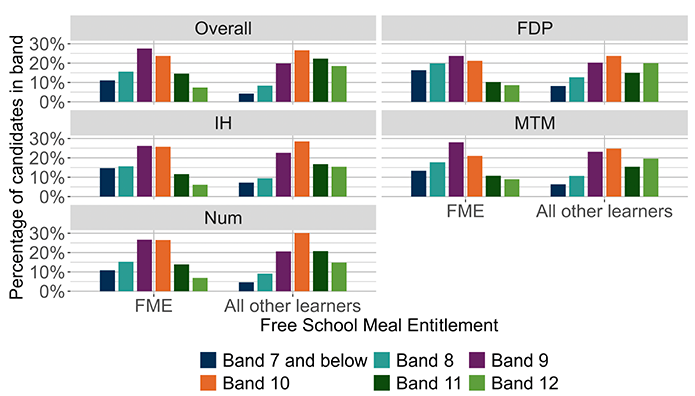
2.3.6 Additional Support Needs
Charts 6a to 6d show numeracy outcomes of learners according to whether or not learners were registered as learners with Additional Support Needs (ASN), distinguishing those registered as learners with ASN from all other learners, for each stage (P1, P4, P7 and S3). Outcomes are given for the overall outcomes and by organiser.
For all stages, the proportions of learners in the two upper bands were notably larger among learners without ASN. Similarly, there were relatively larger proportions of learners with ASN in the two lower bands. These differences were similar for numeracy overall as well as when considering each organiser separately.
While in P1, differences between the proportions of learners with and without ASN in the two lower bands were somewhat less pronounced, at P4, P7 and S3, there tended to be just under 30 percent of learners with ASN in the two lower bands, compared to less than 15 percent of learners without ASN.
Chart 6a. SNSA Numeracy outcomes distributed by ASN for P1
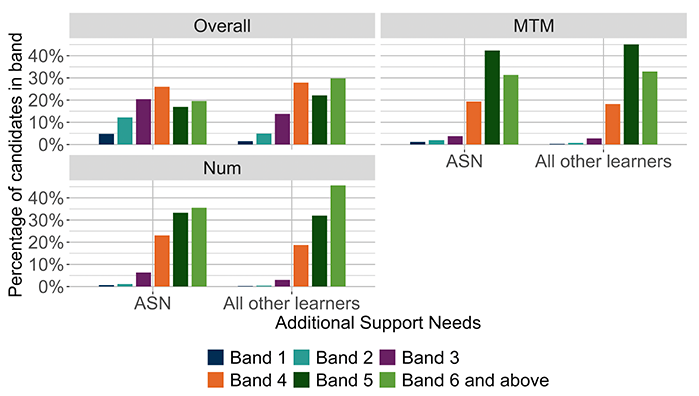
Chart 6b. SNSA Numeracy outcomes distributed by ASN for P4
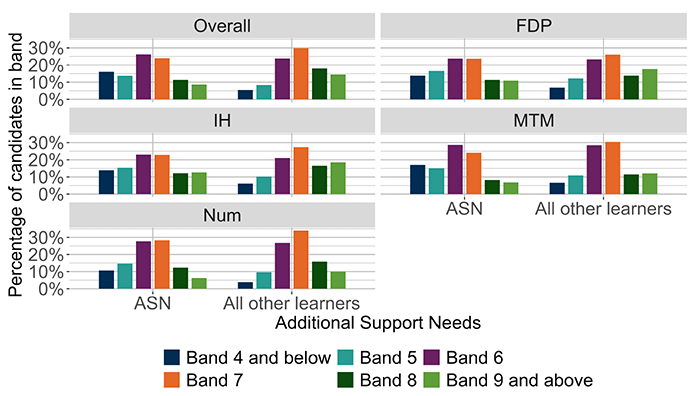
Chart 6c. SNSA Numeracy outcomes distributed by ASN for P7

Chart 6d. SNSA Numeracy outcomes distributed by ASN for S3
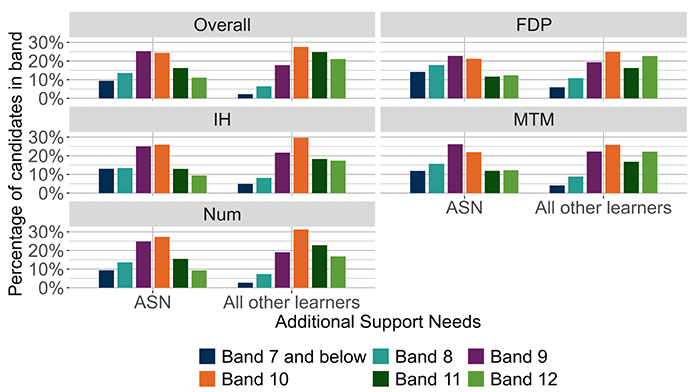
2.3.7 Looked After Children
Charts 7a to 7d show numeracy outcomes of learners according to whether or not learners were learners who were classified as Looked After Children (LAC) either at Home or Away from Home. The information was taken from the national database, SEEMiS, and compares LAC with all other learners, for each stage (P1, P4, P7 and S3). Outcomes are given for the overall outcomes and by organiser.
Across all stages, among learners classified as Looked After Children, smaller proportions achieved outcomes in the two upper capacity bands, compared to other learners without these classifications, with this trend being most pronounced at S3. Similarly, for the lower capacity bands, there was a higher proportion of learners classified as Looked After Children achieving these outcomes compared to all other learners. These patterns can be seen across stages and generally hold for organiser outcomes in addition to the overall summaries.
Chart 7a. SNSA Numeracy outcomes distributed by LAC for P1
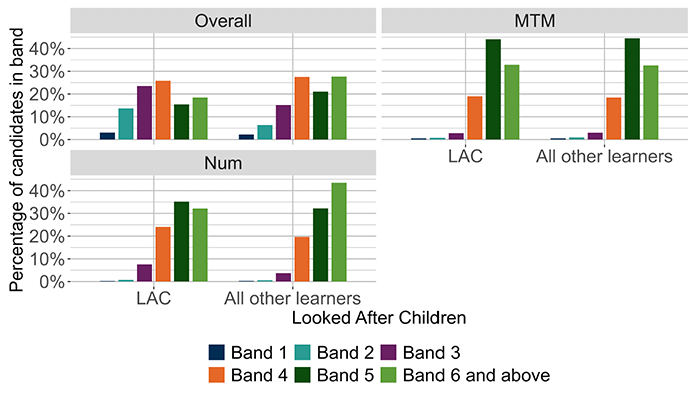
Chart 7b. SNSA Numeracy outcomes distributed by LAC for P4
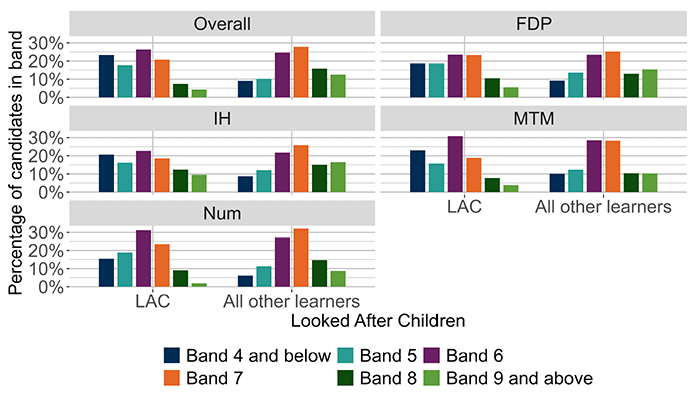
Chart 7c. SNSA Numeracy outcomes distributed by LAC for P7
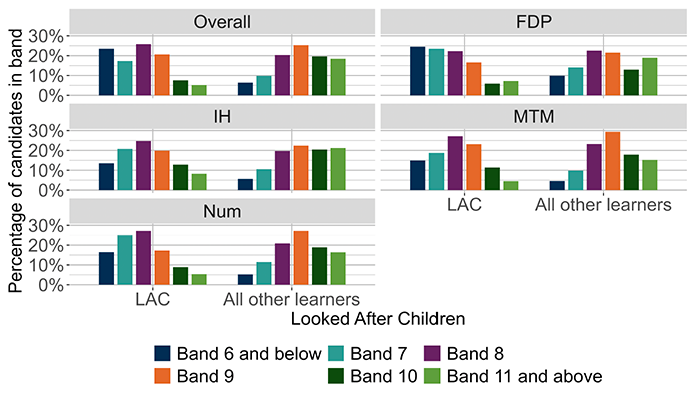
Chart 7d. SNSA Numeracy outcomes distributed by LAC for S3
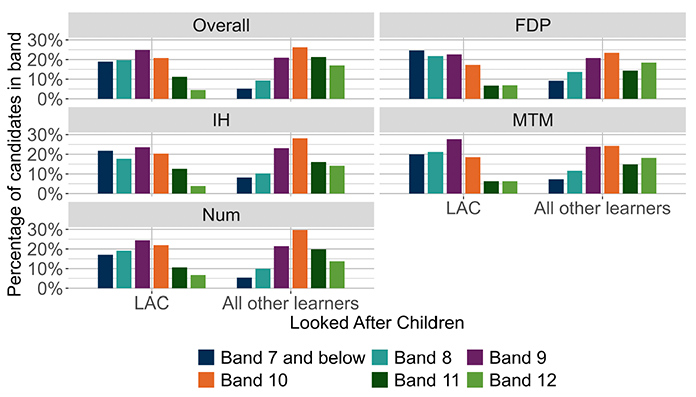
2.3.8 English as an Additional Language
Charts 8a to 8d show numeracy outcomes of learners according to language background and compares English as an Additional Language (EAL) with all other learners, for each stage (P1, P4, P7 and S3). Outcomes are given for the overall outcomes and by organiser.
When comparing learners for whom English is an Additional Language (EAL) and those for whom English is their first language at P4, P7 and S3, we observed only relatively small differences in the proportion of learners achieving outcomes in the lowest two and highest two capacity bands. When comparing proportions in bands for each organiser, we observed very similar outcomes between the two groups, with only slightly larger proportions of learners who do not have English as their first language achieving outcomes in the highest two bands at S3.
At P1, differences between the two groups were larger than for the other stages, with greater proportions of EAL learners achieving outcomes in the lowest capacity bands than other learners and lower proportions achieving the higher capacity bands than other learners.
Chart 8a. SNSA Numeracy outcomes distributed by EAL for P1
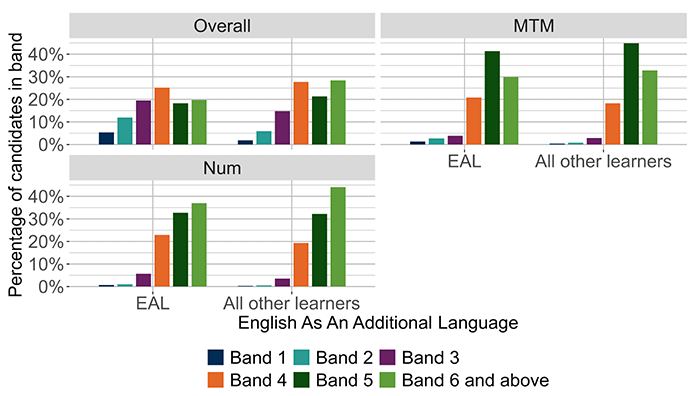
Chart 8b. SNSA Numeracy outcomes distributed by EAL for P4
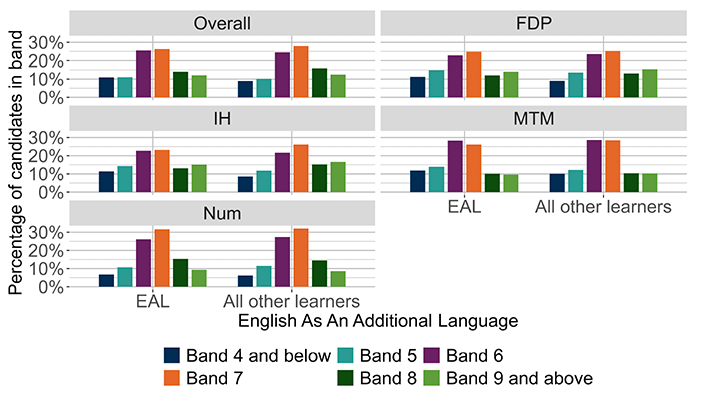
Chart 8c. SNSA Numeracy outcomes distributed by EAL for P7
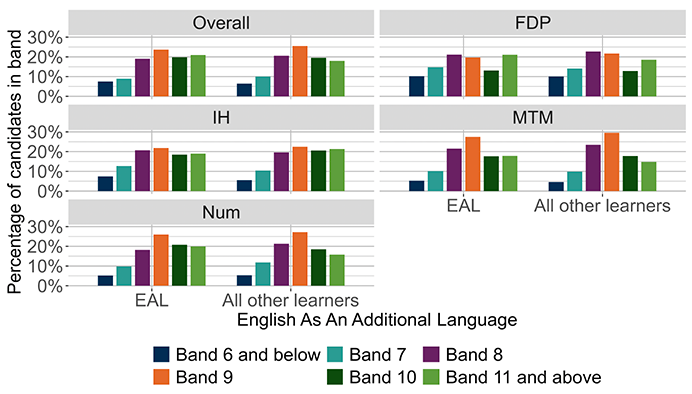
Chart 8d. SNSA Numeracy outcomes distributed by EAL for S3
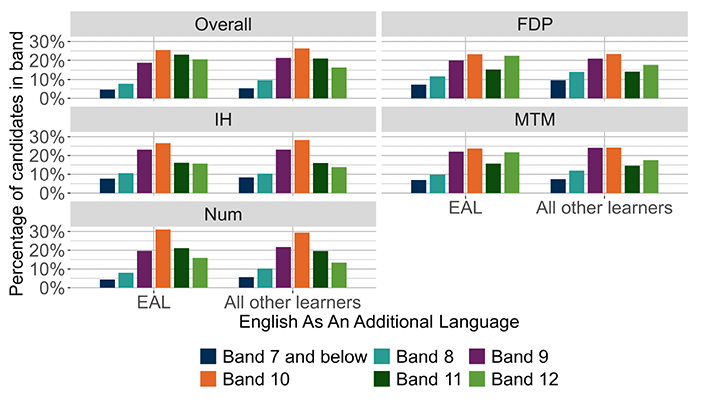
2.4 MCNG National outcomes for numeracy
2.4.1 Overall outcomes
Charts 9a and 9b show for stages P4 and P7 the overall outcomes of learners for numeracy. Where learners are presented with more than 5 items per organiser, they additionally show the outcomes of learners according to the knowledge organisers: Number (NUM), Fractions, Decimal fractions and Percentages (FDP), Measurement, Time and Money (MTM) and Information Handling (IH). The bars show outcomes across the six capacity bands that are specific to each stage, in line with MCNG reports for the academic year 2023 to 2024.
For P4 the upper bands were the most frequently achieved and for P7 learners, the mid to upper bands were the most frequently achieved by learners. In line with ONS guidelines the data for P1 and S3 is not reported in order to avoid identifying individual learners.
Please note that for all charts, a notable difference refers to a difference of 10 percent or more, a small difference refers to any difference between 5 percent and 10 percent.
Chart 9a. MCNG Numeracy outcomes for P4
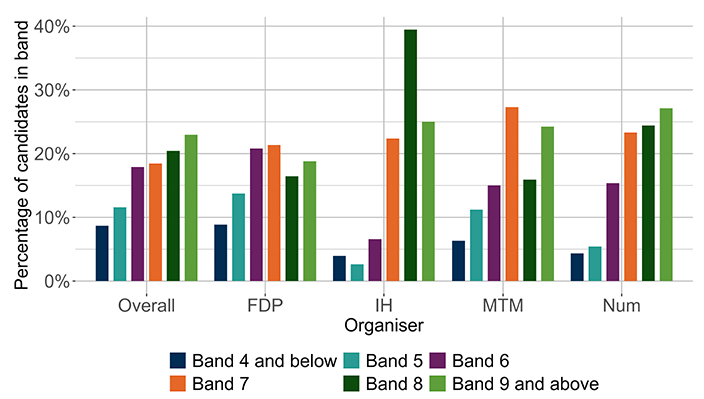
Overall for P4, the band achieved by the largest proportion of learners was band 9, with 23.0 percent of learners achieving this band. The second most common band achieved by learners was band 8 and the band achieved by the smallest proportion of participants was band 4 with only 8.7 percent of learners scoring in this band. Approximately 61.8 percent of learners achieved bands 7 to 9 and 79.7 percent of learners achieved bands 6 to 9.
For the 'Fractions, decimal fractions and percentages' organiser, 56.6 percent of learners achieved bands 7 to 9 and 77.4 percent of learners achieved bands 6 to 9. The modal band for this organiser differed from the Overall summary, with the band achieved by the largest proportion of learners instead being band 7.
For the 'Information handling' organiser, 64.5 percent of learners achieved bands 8 and 9 and 86.8 percent of learners achieved bands 7 to 9. The modal band for this organiser differed from the Overall summary, with the band achieved by the largest proportion of learners instead being band 8.
For the 'Money, time and measurement' organiser, 67.5 percent of learners achieved bands 7 to 9 and 82.5 percent of learners achieved bands 6 to 9. The modal band for this organiser differed from the Overall summary, with the band achieved by the largest proportion of learners instead being band 7.
For the 'Number' organiser, 51.5 percent of learners achieved bands 8 and 9 and 90.2 percent of learners achieved bands 6 to 9. As with the overall summary, the 'Number' organiser had the largest proportion of learners achieving outcomes in band 9.
Chart 9b. MCNG Numeracy outcomes for P7
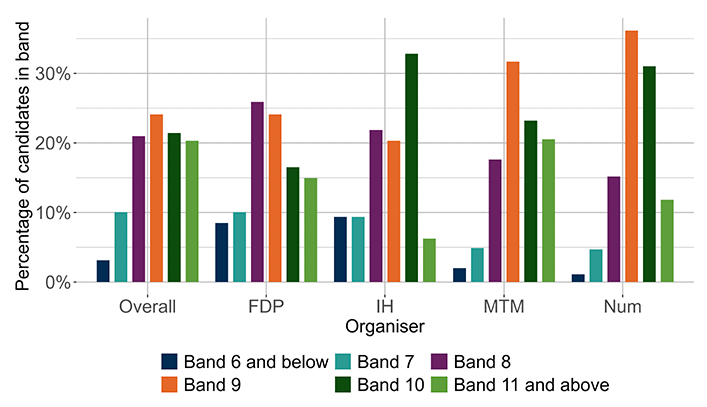
Overall, for P7, the band achieved by the largest proportion of learners was band 9, with 24.1 percent of learners achieving this band. The second most common band achieved by learners was band 10 and the band achieved by the smallest proportion of participants was band 6 with only 3.1 percent of learners scoring in this band. Approximately 66.5 percent of learners achieved bands 8 to 10 and 96.9 percent of learners achieved bands 7 to 11.
For the 'Fractions, decimal fractions and percentages' organiser, 66.5 percent of learners achieved bands 8 to 10 and 91.5 percent of learners achieved bands 7 to 11. The modal band for this organiser differed from the Overall summary, with the band achieved by the largest proportion of learners instead being band 8.
For the 'Information handling' organiser, 75 percent of learners achieved bands 8 to 10. The modal band for this organiser differed from the Overall summary, with the band achieved by the largest proportion of learners instead being band 10.
For the 'Money, time and measurement' organiser, 72.5 percent of learners achieved bands 8 to 10 and 98 percent of learners achieved bands 7 to 11. As with the overall summary, the 'Money, time and measurement' organiser had the largest proportion of learners achieving outcomes in band 9.
For the 'Number' organiser, 82.4 percent of learners achieved bands 8 to 10. As with the overall summary, the 'Number' organiser had the largest proportion of learners achieving outcomes in band 9.
2.4.2 Sex
Chart 10 shows outcomes for male and female learners for stage P4. Outcomes are given for the overall outcomes and by organiser.
For P4, overall, there were differences in the proportion of male and female learners achieving outcomes in the highest band, with a greater percentage of male learners achieving this outcome. This pattern holds for the organisers, with the exception of the IH organiser. Overall, in the lowest capacity bands, a greater proportion of female learners achieved these outcome bands than males. This pattern is not always consistent at the organiser level.
In line with ONS guidelines the data for P1, P7 and S3 is not reported in order to avoid identifying individual learners.
Chart 10. MCNG Numeracy outcomes distributed by sex for P4
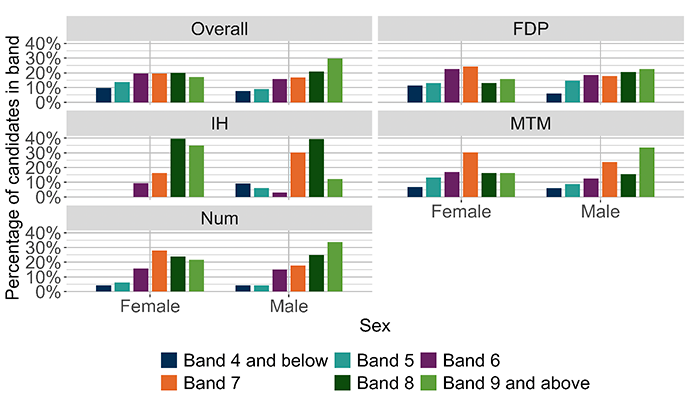
Overall, there were notable differences between the proportion of females and males achieving outcomes in band 9 with, proportionally, more male learners achieving outcomes in this band than female learners.
For the 'Fractions, decimal fractions and percentages' organiser, there were small differences between the proportion of females and males achieving outcomes in bands 4 and 7 to 9.
Whilst there were notable differences between the proportion of females and males achieving outcomes in bands 7 and 9 and small differences in band 6 for the 'Information handling' organiser, the number of learners in these categories is very low so any inferences regarding ability should be made with caution as this does not represent a significant difference in terms of raw numbers.
For the 'Money, time and measurement' organiser, there were notable differences between the proportion of females and males achieving outcomes in band 9. There were small differences between the proportion of females and males achieving outcomes in band 7.
For the 'Number' organiser, there were notable differences between the proportion of females and males achieving outcomes in bands 7 and 9.
2.4.3 Scottish Index of Multiple Deprivation
In line with ONS guidelines the data for P1, P4, P7 and S3 is not reported in order to avoid identifying individual learners.
2.4.4 Ethnic background
In line with ONS guidelines the data for P1, P4, P7 and S3 is not reported in order to avoid identifying individual learners.
2.4.5 Free School Meal Entitlement
Charts 11a and 11b shows numeracy outcomes of learners according to entitlement to free school meals (FME), distinguishing those with entitlement from all other learners, for the P4 stage. Outcomes are given for the overall outcomes and by organiser.
Overall, for P4, there were slightly larger proportions of learners with outcomes in the upper two bands among learners entitled to free school meals (FME) than for those not entitled to free school meals. Correspondingly, there were higher proportions of outcomes in the lowest capacity band among learners not entitled to free school meals. This pattern was evident for numeracy overall and by organiser.
In line with ONS guidelines the data for P1, P7 and S3 is not reported in order to avoid identifying individual learners.
Chart 11a. MCNG Numeracy outcomes distributed by FME for P4 with the exception of Information Handling
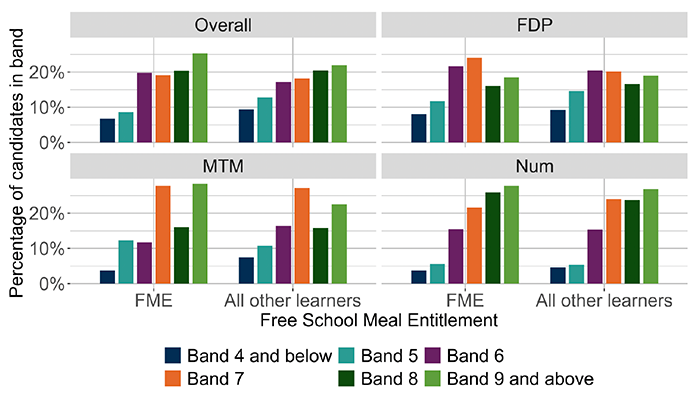
Chart 11b. MCNG Numeracy outcomes distributed by FME for P4 by organiser ‘Information Handling’
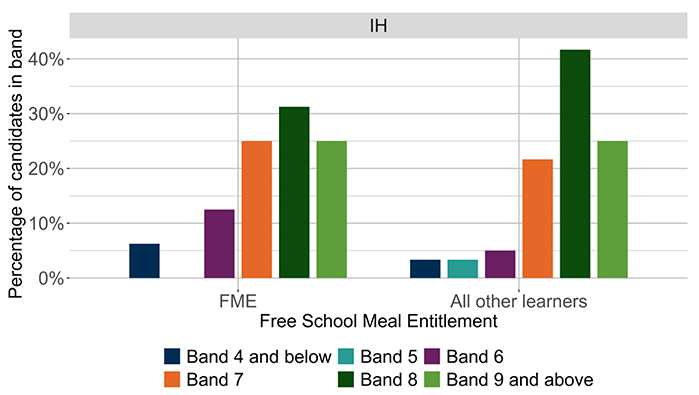
The Information Handling organiser has been separated from the overall outcomes and other organisers to allow easier review of the overall outcomes. Please note that these two charts use different scales.
Overall, there were no notable or small differences between the proportion of all other learners and learners that are entitled to FME achieving outcomes in each band.
2.4.6 Additional Support Needs
Charts 12a and 12b show writing outcomes of learners according to whether or not learners were registered as learners with Additional Support Needs (ASN), distinguishing those registered as learners with ASN from all other learners, for P4. Outcomes are given for the overall outcomes and by organiser.
For P4, the proportions of learners in the two upper bands were notably larger among learners without ASN. Similarly, there were relatively larger proportions of learners with ASN in the two lower bands. These differences were similar for numeracy overall as well as when considering each organiser separately.
In line with ONS guidelines the data for P1, P7 and S3 is not reported in order to avoid identifying individual learners.
Chart 12a. MCNG Numeracy outcomes distributed by ASN for P4 with the exception of Information Handling
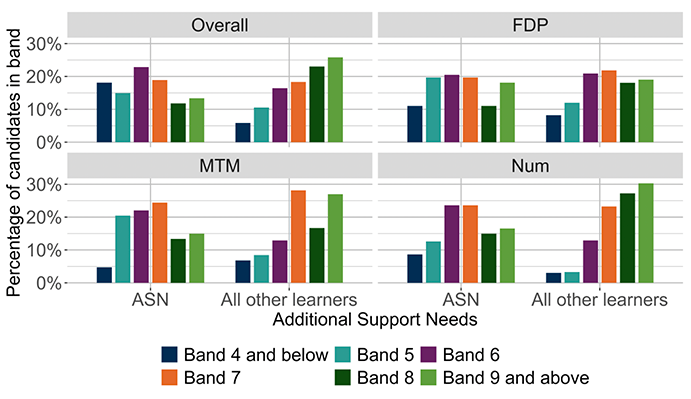
Chart 12b. MCNG Numeracy outcomes distributed by ASN for P4 by organiser ‘Information Handling’
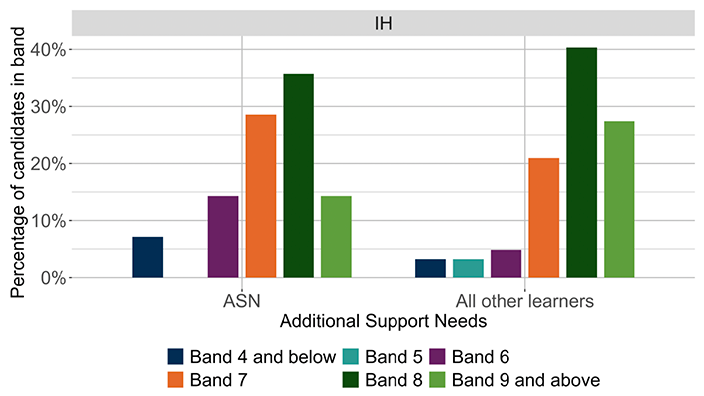
The Information Handling organiser has been separated from the overall outcomes and other organisers to allow easier review of the overall outcomes. Please note that these two charts use different scales.
2.4.7 Looked After Children
In line with ONS guidelines the data for P1, P4, P7 and S3 is not reported in order to avoid identifying individual learners.
2.4.8 English as an Additional Language
In line with ONS guidelines the data for P1, P4, P7 and S3 is not reported in order to avoid identifying individual learners.
Contact
There is a problem
Thanks for your feedback